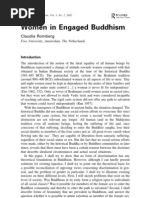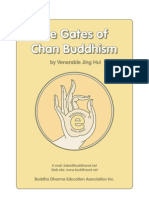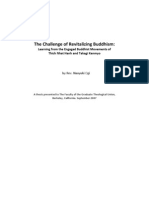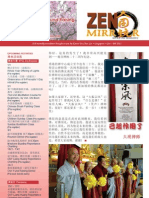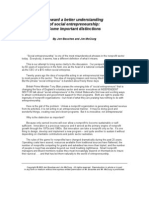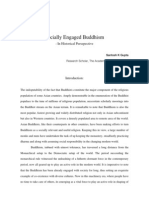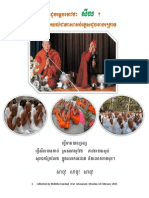You Too Can Be A Bodhisattva
Uploaded by
Low Beng KiatYou Too Can Be A Bodhisattva
Uploaded by
Low Beng KiatYou Too Can Be a Bodhisattva
by Diana Winston
hese days,more than ever, we need to put on our bodhisattva shoes. But what does it mean to embody the bodhisattva ideal in these times? What is the history of this ideal? What are the tools a bodhisattva needs along the path? What are the obstacles a bodhisattva meets along the way? And what is the fruition of stepping onto the bodhisattva path?
History In early Buddhism the term bodhisattva was applied to the Buddhas previous lives. The Jataka Tales tell of the Buddhas lives as a tiger or a parrot, for example, when he was a bodhisattva, or Buddha-to-be. It took him thousands of lifetimes of making merit to become the one we call the Buddha, the Awakened One. Theravadin Buddhism emphasizes the arhat path, the ideal of attaining complete liberation in this lifetime. Some people say this is selfish. What about all the suffering beings? But I think its a misunderstanding to view arhats as selfish; in fact they have extraordinary wisdom and compassion. Its just that a different aspect of the path is being emphasized. The term bodhisattva, on the other hand, came to mean, over time, a being who is becoming liberated for the sake of all beings. The bodhisattva practices to end suffering for everyone. The bodhisattva never turns away. Until modern times, the suffering was assumed to be personal suffering; social and political suffering wasnt necessarily what the Buddha was talking about. In some Mahayana traditions, the bodhisattva is one who actually postpones his or her enlightenment and continues to be reborn in the realm of samsara,in order to help all other b eings reach enlightenment. Shantideva, the seventh-century author of The Bodhisattvas Guide to Life, mentions this vow of the bodhisattva:For as long as space exists, and sentient beings endure, may I stay to dispel the misery of the world. Or in a more poetic translation:May I be the living ground of love for all beings. I love that! We can each make a decision to step onto the bodhisattva path. It doesnt matter whether we identify as Theravadin or Mahayanin. Anyone can do it. In some traditions of Buddhism, like Zen, people automatically take the b odhisattva vow. In some zendos the vow is chanted daily: Beings are numberless, I vow to save them. Delusions are inexhaustible, I vow to end them. Dharma gates are boundless, I vow to enter them. Buddhas way is unsurpassable, I vow to become it.
In the Tibetan tradition, practitioners consciously decide to take the bodhisattva vows. They say, Now Im ready. Im going to do it, and they commit to enlightenment for the sake of all beings. And this speeds up their practice, because once they do this, it means that theyre serious. It lights a fire under their practice,and then they can get enlightened super fast! The bodhisattva is a wonderful and useful archetype for our work as socially engaged Buddhists, although in traditional Buddhist circles the bodhisattva is often viewed as an exalted being, like Kuan Yin, or Avalokitesvara, or Samantabadragodlike d eities of the Buddhist pantheon. So, ordinary people say I cant be a bodhisattva. Thats grandiose. Thats ridiculous. But the bodhisattva is an archetype that makes sense for these times. Its not about grandiosity or trying to be great. Its just that theres so much suff ering these days and we want to do what we can to liberate beings and to liberate the world. What would be the social ly engaged version of the bodhisattva path? It means taking our power. It means choosing to act with as much wisdom and compassion as we possibly can. And it means settling for nothing less than full liberation of the personal, relational, social, and political realms of existence. Thats not the classical Buddhist understanding, but I think its the understanding that our times require. The Tool Kit We have several tools to work with, as budding bodhisattvas. Intention The first thing in our tool kit is our intention. This is connected with the concept of bodhicitta, familiar to Tibetan practitioners. Bodhi means awakened, and citta means heart, or mind. So, bodhicitta is the aspiration for an awakened heart and mind. Having true bodhicitta is enormously difficult. His Holiness the Dalai Lama says that he thinks that maybe once or twice he has experienced bodhicitta! His Holiness is quite modest, but what he says indicates that bodhicitta is really a big deal. He says that if youve had it even for one second, its an amazingly profound experience. But we can have it,the intention to develop bodhicitta, even if its only a glimmer. We can set our motivation. We can say prayers like the one in the Tibetan tradition: May the precious bodhicitta arise where it has not arisen. And where it has arisen, may it not decrease, but increase, further and further. I try to say that prayer every morning. I
Sometimes when were cooking at a soup kitchen or planning a protest, we think: Its not me doing this! Its as though something is coming through us.
vowing peace
forget a lot, but I try to say it as much as possible.May the aspiration for the awakened heart and mind grow and grow and grow. Spiritual Practice The next thing the bodhisattva has in her tool kit is her spiritual practice. For many of us, this is a meditation practice. For others it might be chanting, visualization, or other devotional practices. Whatever helps us to know ourselves more clearly is a useful tool. For myself I can say that because of my meditation practice I can see things more clearly and I can see myself more clearly. Its really simple. Because of my meditation practice, wisdom grows, compassion grows. We also learn from our practice that its not really me trying to help the world. When we sit in meditation, we see phenomena rise and pass away. We watch ourselves with this thought or that feelingOh yeah! Im angry! Im fearful!and then we see that these are just movements of the mind. And as we do this, day after day, the mind relaxes some, and lets go. Then what happens is we begin to be less identified with our sense of self when we are off the meditation cushion. Sometimes this happens when were in a service or social-change situation like cooking at a soup kitchen or planning a protest, and we think: Its not me doing this! Its as though something is coming through us. Putting our spiritual practice into our tool kit also means, at times, taking time out to practice or go on a retreat. Bodhisattvas can be greatly nourished by going on a retreat and not doing anything for a little while. We must learn to respect our cycles of being in and out of the world of activity. Non-attachment The tool kit is stocked with lots of non-attachment. Because of my meditation practice, because I am doing the work every moment of letting go, or of trying to let go, Im less attached to the results of my actions.A bodhisattva has got to be non-attached! But keep in mind that were talking about an ideal here. So of course were attached,as long as were human.Still, this is our vision,and we can take steps towards it. I encourage bodhisattvas to think in terms of geological time. Theres so much work to do, and if we get impatient about results, we are only going to suffer. I often feel kind of hopeless. The misery of the world seems so profound these days, set into stark relief by recent events. But from the long-term perspective, patience is whats called for. We dont have to change things overnight. But this doesnt mean that theres so much time that we can be lazy. It means acting with simultaneous passion and non-attachment. Action The fourth tool in the bodhisattvas tool kit is action itself. Even when she feels exhausted or like nothing is
worth doing, the bodhisattva still acts, but not in a blind way. She knows how to respect her limits. But her action is a flowering of her practice; she comes into her buddha nature through each act of making change. One way to think about this is that when we act, we develop what are called the Paramitas, or the Perfections, of Virtue: generosity, ethics, patience, effort, meditation, and wisdom. Generosity is developed through service, through social-change work. So are the others .D ay after day, we show up at the clinic or the march, or create new institutions, or protest even though we think people are laughing at us. Through these actions we develop perseverance and generosity of heart, which is a deepening of our spiritual practice. In traditional social-change circles, acting may not be considered particularly spiritual, but for the bodhisattva, working for change is a profoundly spiritual act. History and Analysis The fifth thing in the b odhisattvas tool kit is analysis. The bodhisattvas work is grounded in what people have done before us. Its grounded in knowing Gandhi and Martin Luther King, Jr., and the history of nonviolence teachings. The bodhisattva is very happy to study feminism, labor movements, liberation theology, and all of the work thats been done on issues of racism, for instance. And of course the bodhisattva is well versed in dharma teachings. All of this study gives the bodhisattva a practical background for making decisions and creating strategy. Community The sixth tool in the bodhisattvas tool kit is community. The bodhisattva doesnt like to act alone. The bodhisattva gets very lonely! Therefore we create community around the work that were doing, so that we all can be bodhisattvas together. I have a dear friend who told me that when he took on the bodhisattva vows, he felt very heavy, as though he had taken on the weight of the whole world. But after a time he realized,Hey, wait a minute! I took the bodhisattva vowbut so did a whole lot o f other people! Wait a minute! A lot of us are carrying the weight of the world! Its not that hard! If we can create community around us, then well be in good shape. Then well have mirrors to reflect back our mistakes when we screw up. And when were doing great we can celebrate together, and play! Obstacles on the Path There are countless obstacles we will encounter when we embark on the bodhisattva path. A major one is doubt. Who, me? A bodhisattva? You gotta be kidding! Thats super grandiose. Im just an ordinary person. Well yes, we are ordinary people. And, we can have extraordinary motivation. Whats wrong with that?
A relevant and useful book about the history of the bodhisattva archetypes and about contemporary exemplars is Taigen Dan Leightons Bodhisattva Archetypes: Classic Buddhist Guides to Awakening and Their Modern Expression (Penguin, $14.95)
vowing peace
Self-judgment may also arise: Oh, Im the worst bodhisattva in the history of the entire world! Its probably not true. If were really filled with self-judgment we can talk to ourselves and say, Well, you know, Im not doing too bad, for a bodhisattva in training. Another difficulty that we often have is that we dont know where to act. The world is a mess. How can we find the place where we can best contribute? We can get paralyzed by this feeling. Best here is to follow our hearts. Go to the place we feel drawn to, whether it is helping kids read or overthrowing global capitalism. If our hearts are there, thats where we will do the best work. Another obstacle is the feeling Oh no! This is too soon! Im not ready! I think the events of 9/11 gave us a really big message about being ready. What I felt inside myself was that its time to step into our power now, regardless of how ready we think we are. The world situation is so critical that if were going to embody peace and work for change, now is the time. Fruition Ultimately, the fruit of the bodhisattva path is a meaningful life. Its a life where our highest spiritual and social ideals are completely merged. Its a life where we can look into our hearts and say, Yes,this is a life well-lived. The bodhisattva path is a commitment,its a huge deal. At the same time, when we give ourselves this challenge, we find ourselves rising to the occasion,and we say, Yeah,I can do this! Why not?! Because deep inside us, were noticing that it feels right,and were willing to take it on. Actually, we have no choice. Its a commitment to our own healing, and to the healing of the world.A Hopi Elder said:
You have been telling the people that this is the eleventh hour. Now you must go back and tell the people that this is the hour, and there are things to be considered. Where are you living? What are you doing? What are your relationships? Are you in right relationship? Where is your water? Know your garden. Its time to speak your truth, to create your communities, to be good to each other, and not look outside yourself for a leader At this time in history, we are to take nothing personally, least of all ourselves. For the moment that we do that, our spiritual growth comes to a halt. The time of the lone wolf is over. Gather yourselves. Banish the word struggle from your attitude and vocabulary. All that we do now must be done in a sacred way, and in celebration. We are the ones weve been waiting for. y [This ar ticle is based on a talk given at Southern Dharma Retreat Center, Hot Springs, North Carolina, on October 7, 2001,the day the U.S. began bombing Afghanistan.] Diana Winston is Associate Director of the Buddhist Peace Fellowship.
You might also like
- Full Open Heart Open Mind Awakening The Power of Essence Love 1st Edition Tsoknyi Rinpoche PDF All Chapters100% (13)Full Open Heart Open Mind Awakening The Power of Essence Love 1st Edition Tsoknyi Rinpoche PDF All Chapters70 pages
- Handbook of Bodhisattva Precepts for Laypeople 在家菩薩戒手冊 (Eng.Chi)No ratings yetHandbook of Bodhisattva Precepts for Laypeople 在家菩薩戒手冊 (Eng.Chi)225 pages
- Did The Buddha Impart An Esoteric Teaching (Clearscan)0% (1)Did The Buddha Impart An Esoteric Teaching (Clearscan)18 pages
- Cho, Francisca - Seeing Like The Buddha Enlightenment Through Film-State University of New York Press (2017)No ratings yetCho, Francisca - Seeing Like The Buddha Enlightenment Through Film-State University of New York Press (2017)192 pages
- Treeleaf Priest Training Program - Jan2010No ratings yetTreeleaf Priest Training Program - Jan201033 pages
- The Bodhisattva Precepts For Laypeople - EnglishNo ratings yetThe Bodhisattva Precepts For Laypeople - English13 pages
- A Mind To Fight - Conflict Resolution and Buddhist PracticesNo ratings yetA Mind To Fight - Conflict Resolution and Buddhist Practices15 pages
- A Guide To The Bodhisattvas Way of LifeNo ratings yetA Guide To The Bodhisattvas Way of Life126 pages
- Healing Power of Mindfulness MeditationNo ratings yetHealing Power of Mindfulness Meditation98 pages
- The Royal Seal of Mahamudra, Volume Two: A Guidebook for the Realization of CoemergenceFrom EverandThe Royal Seal of Mahamudra, Volume Two: A Guidebook for the Realization of CoemergenceNo ratings yet
- The Zen of Hubert Benoit Joseph Hart PDFNo ratings yetThe Zen of Hubert Benoit Joseph Hart PDF27 pages
- The Magic of The Mind, An Exposition of The Kalakarama Sutta100% (1)The Magic of The Mind, An Exposition of The Kalakarama Sutta13 pages
- Tantras of Tibetan Medicine Yuthok Yonten Gonpo_ H.H. the Dalai Lama - The Root Tantra and The Explanatory Tantra_ from the Secret Quintessential Instructions on the Eight Branches of the Ambrosia E (2011, Men-Tsee-Khang ( - libgen.liNo ratings yetTantras of Tibetan Medicine Yuthok Yonten Gonpo_ H.H. the Dalai Lama - The Root Tantra and The Explanatory Tantra_ from the Secret Quintessential Instructions on the Eight Branches of the Ambrosia E (2011, Men-Tsee-Khang ( - libgen.li386 pages
- Royal Commission Into Institutional Responses To Child Abuse, Transcript, Day 104No ratings yetRoyal Commission Into Institutional Responses To Child Abuse, Transcript, Day 104125 pages
- On The Problem of The External World in The Ch'eng Wei Shih LunNo ratings yetOn The Problem of The External World in The Ch'eng Wei Shih Lun66 pages
- The Royal Seal of Mahamudra, Volume One: A Guidebook for the Realization of CoemergenceFrom EverandThe Royal Seal of Mahamudra, Volume One: A Guidebook for the Realization of CoemergenceNo ratings yet
- Footprints in The Dust: The Life of The Buddha From The Most Ancient Sources - DhammikaNo ratings yetFootprints in The Dust: The Life of The Buddha From The Most Ancient Sources - Dhammika305 pages
- The Diamond Sutra and The Sutra of Hui neng 4th Edition Wong Mou-Lam pdf download50% (2)The Diamond Sutra and The Sutra of Hui neng 4th Edition Wong Mou-Lam pdf download52 pages
- Rivers To The Sky Transformation Metapho PDFNo ratings yetRivers To The Sky Transformation Metapho PDF16 pages
- Atisha The Bodhisattva's Garland of JewelsNo ratings yetAtisha The Bodhisattva's Garland of Jewels4 pages
- Contemporary Buddhism Volume Issue 2019 (Doi 10.1080 - 14639947.2018.1576292) Lee, Kin Cheung (George) Chez Kuang, Ong - The Satipa Hāna Sutta - An Application of Buddhist Mindfulness For CounselloNo ratings yetContemporary Buddhism Volume Issue 2019 (Doi 10.1080 - 14639947.2018.1576292) Lee, Kin Cheung (George) Chez Kuang, Ong - The Satipa Hāna Sutta - An Application of Buddhist Mindfulness For Counsello16 pages
- Daniel Henning - Buddhism and Deep EcologyNo ratings yetDaniel Henning - Buddhism and Deep Ecology5 pages
- The Ontological Foundation of Religious Praxis in Yogacara Buddhism - Madhyantavibhagakarika 1.1No ratings yetThe Ontological Foundation of Religious Praxis in Yogacara Buddhism - Madhyantavibhagakarika 1.118 pages
- The Role of The Good Friend in The Gandavyuha SutraNo ratings yetThe Role of The Good Friend in The Gandavyuha Sutra7 pages
- Thich Nhat Hanh - The Diamond Sutra 2 (5p) PDFNo ratings yetThich Nhat Hanh - The Diamond Sutra 2 (5p) PDF5 pages
- The Five Niyāmas As Laws of Nature: An Assessment of Modern Western Interpretations of Theravāda Buddhist DoctrineNo ratings yetThe Five Niyāmas As Laws of Nature: An Assessment of Modern Western Interpretations of Theravāda Buddhist Doctrine40 pages
- Acharya Lama Kelzang Wangdi White Arya Tara100% (1)Acharya Lama Kelzang Wangdi White Arya Tara16 pages
- Awakening through the Nine Bodies: Exploring Levels of Consciousness in MeditationFrom EverandAwakening through the Nine Bodies: Exploring Levels of Consciousness in MeditationNo ratings yet
- Mind Training (Lojong) Collection - LotsawaHouse PDFNo ratings yetMind Training (Lojong) Collection - LotsawaHouse PDF93 pages
- The Roots of Goodness: Zen Master Dogen's Teaching on the Eight Qualities of a Great PersonFrom EverandThe Roots of Goodness: Zen Master Dogen's Teaching on the Eight Qualities of a Great PersonNo ratings yet
- Footprints on the Journey: One Year Following the Path of Dzogchen Master Khenpo SodargyeFrom EverandFootprints on the Journey: One Year Following the Path of Dzogchen Master Khenpo SodargyeNo ratings yet
- The Psychologically Beneficial Aspects of PhotographyNo ratings yetThe Psychologically Beneficial Aspects of Photography44 pages
- (Ebook) The People Of Forever Are Not Afraid by Shani Boianjiu ISBN 9780099578680, 0099578689 - The ebook in PDF and DOCX formats is ready for download now100% (2)(Ebook) The People Of Forever Are Not Afraid by Shani Boianjiu ISBN 9780099578680, 0099578689 - The ebook in PDF and DOCX formats is ready for download now52 pages
- A Dzogchen View of The Experience of Absence of Self (Anatman)No ratings yetA Dzogchen View of The Experience of Absence of Self (Anatman)21 pages
- Heart Essence of the Vast Expanse: Foundational Practices and the Transmission of the Longchen NyingthigFrom EverandHeart Essence of the Vast Expanse: Foundational Practices and the Transmission of the Longchen NyingthigNo ratings yet
- Profound Instruction On The View of The Middle WayNo ratings yetProfound Instruction On The View of The Middle Way3 pages
- The Tibetan Book of The Great Liberation Padma Sambhava PDFNo ratings yetThe Tibetan Book of The Great Liberation Padma Sambhava PDF104 pages
- Parallels in Engineering and Humanistic Buddhism - by Winie WongNo ratings yetParallels in Engineering and Humanistic Buddhism - by Winie Wong7 pages
- The Effects of A Vegan Diet On Human Health, The Environment, and Animal Welfare As Compared To A Traditional Omnivorous DietNo ratings yetThe Effects of A Vegan Diet On Human Health, The Environment, and Animal Welfare As Compared To A Traditional Omnivorous Diet13 pages
- Buddhism and Animal Rights - Interview With Norm PhelpsNo ratings yetBuddhism and Animal Rights - Interview With Norm Phelps5 pages
- Kwan Yin Chan Lin - Zen Mirror (Eng/Chi) - Jan-Feb 2013No ratings yetKwan Yin Chan Lin - Zen Mirror (Eng/Chi) - Jan-Feb 20138 pages
- Outstanding Social Entrepreneurs 2012 - Schwab FoundationNo ratings yetOutstanding Social Entrepreneurs 2012 - Schwab Foundation212 pages
- 1-4 Boschee, J. y McClurg, J. - Toward A Better Understanding of Social EntrepreneurshipNo ratings yet1-4 Boschee, J. y McClurg, J. - Toward A Better Understanding of Social Entrepreneurship5 pages
- A Map of The Journey - Sayadaw U JotikaNo ratings yetA Map of The Journey - Sayadaw U Jotika398 pages
- Field Guide To Socially Engaged BuddhsimNo ratings yetField Guide To Socially Engaged Buddhsim77 pages
- Socially Engaged Buddhism in Historical Perspective100% (1)Socially Engaged Buddhism in Historical Perspective19 pages
- Attwood, Jayarava Michael 2012-Katyāyana Gotra SūtraNo ratings yetAttwood, Jayarava Michael 2012-Katyāyana Gotra Sūtra3 pages
- A Dogen Zen Story - The Meeting Place of Two LineagesNo ratings yetA Dogen Zen Story - The Meeting Place of Two Lineages4 pages
- Showing Results For: Books by Mahasi SayadawNo ratings yetShowing Results For: Books by Mahasi Sayadaw1 page
- Buddhist Philosophy in Dialogue With Philosophy of Mind and Cognitive ScienceNo ratings yetBuddhist Philosophy in Dialogue With Philosophy of Mind and Cognitive Science3 pages
- Buddhist Studies: Journal of The International Association ofNo ratings yetBuddhist Studies: Journal of The International Association of6 pages
- Ajahn Amaro. the Lesser, The Greater, The Diamond and the WayNo ratings yetAjahn Amaro. the Lesser, The Greater, The Diamond and the Way11 pages
- An introduction to Buddhism teachings history and practices 2nd Edition Peter Harvey - Download the full set of chapters carefully compiled100% (2)An introduction to Buddhism teachings history and practices 2nd Edition Peter Harvey - Download the full set of chapters carefully compiled79 pages
- Introduction To Dhammacakka Pavattana SuttaNo ratings yetIntroduction To Dhammacakka Pavattana Sutta2 pages











